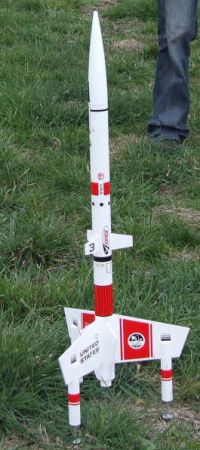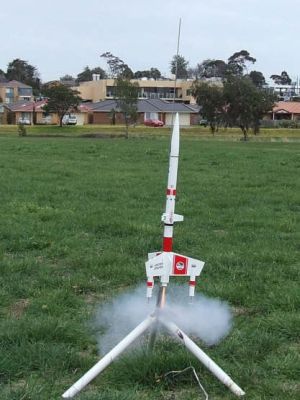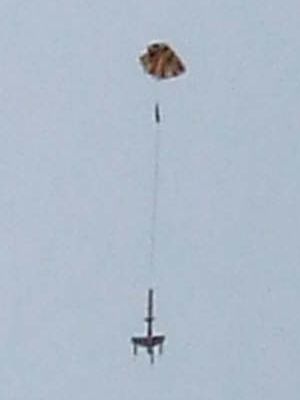| Construction Rating: | starstarstarstar_borderstar_border |
| Flight Rating: | starstarstarstarstar_border |
| Overall Rating: | starstarstarstarstar_border |
| Manufacturer: | Estes  |

Brief:
The Estes Super Vega is a truly glorious upscale of the classic futuristic Estes Starship Vega, and I'd say one of
Estes most appealing and beautiful designs ever to see the light of day. At over 35" in height, this upscale
towers over the original Starship Vega but is sadly now OOP along with its little brother.
Construction:
Included in the comprehensive parts list is:
- 1 plastic nose cone and nozzle
- 1 main BT-60 body tube
- 1 tube coupler
- 1 BT-60 body tube extension
- 3 die-cut balsa main fins
- 3 die-cut balsa ventral fins
- 3 die-cut balsa forward fins
- 6 balsa main fin reinforcement braces
- 1 24mm motor tube
- 1 retainer tube
- 1 motor hook
- 1 thrust ring
- 2 cardboard centering rings
- 3 BT-20 landing pod tubes
- 2 pieces of wood dowel
- 1 die-cut card sheet with patterns to form landing pads
- 1 template sheet
- 2 3/16" launch lugs
- 3 sheets of peel-and-stick decals
- 1 rubber band shock cord
- 1 24" Estes plastic parachute
- 1 set of parachute shroud lines
- 1 set of tape discs
The Super Vega, despite being rated a skill level 4 build, is really not that difficult to construct but the amount of lumber that comes with the rocket will ensure the modeler will be kept quite busy. Instructions were typically comprehensive Estes, logical and very easy to understand to the point where it is quite possible a novice would have no problems constructing a Super Vega so long as the instructions are closely followed. Component quality was generally good although I was unhappy with the quality of the die-cut balsa for the fins which was quite roughly die-cut and required several applications of NHP Micro-Fill balsa filler to fill in several pitted spots.
Great Planes Pro yellow wood glue was mostly used throughout this build with occasional use of Flash medium CA and NHP 12-minute epoxy.
The motor mount was constructed like any other conventional low-power rocket with a motor tube and two centering rings although an interesting touch was the retainer tube which is slipped over and glued to the motor tube before gluing on the centering rings. I opted at this stage to ditch the standard Estes tri-fold mount and (ridiculously) short rubber band shock cord and upgrade to a Kevlar®/elastic shock cord combination with a 60" length of 1/4 elastic. With the new recovery system mounted in place and after applying generous yellow glue fillets to both the front and rear centering rings, the completed motor mount was then glued into the main body tube with generous glue fillets later applied to the rear centering ring/main body tube join. Following on, I glued the tube coupler into place on the main body tube and once the glue had dried, I glued the body extension tube in place.
I then proceeded to slightly roughen up the main and extension body tubes with 240 grit sandpaper to enable better glue and paint adhesion after which I tackled the fin marking steps. Fin marking is helped along with supplied wraparound templates with markings for both the main/forward and ventral fins. The main fins are two-piece and are formed by gluing a short fin extension to each main fin, quite a simple step if wood glue is used using the "double glue" method. I wished to add as much strength as possible to the main fins so I deviated from the instructions to laminate the main fins with computer paper and watered-down white glue. After being placed under three stacked telephone books for a week to prevent fin warp during the drying process, the laminated fins were attached to the body tube using wood glue with a drop of medium CA at each end. With the main fins set in place, the balsa fin reinforcement braces were then glued to each main fin root edge/body tube join with multiple wood glue fillets then added for strength. The forward fins were then glued into place with careful alignment with the main fins followed by the ventral fins. Multiple wood glue fillets were then added to the forward and ventral fins. Lastly, the two 3/16" launch lugs were glued into place with one being glued to the side of a ventral fin and the second lug glued into place between two of the forward fins.
The wood dowels were then cut into three 7 1/4" lengths to which two rings from the die-cut card sheet were glued into place at intervals along each piece of dowel with the finished pieces then glued into a landing pod tube to form proper landing pods. The remaining rings were glued together to form landing pads for the landing pods, the completed landing pads were then glued to the end of each landing pod dowel.
After marking alignment lines on the landing pods with the aid of another supplied alignment template, the landing pods were each glued into the slots of a main fin. To ensure best possible strength, I used 12-minute epoxy to form small fillets for each landing pod/main fin slot join.
Finishing:
For initial finishing I proceeded to roughen up the plastic nose cone with wet 180 grit sandpaper and primed it with
two coats of Tamiya Fine White spray primer with light sanding in between. I then sealed the landing pod legs and
landing pads with three coats of Aeroflyte Acetone Dope and followed this up with filling in the forward and ventral
fins with six coats of NHP Micro-Fill which nicely sealed all the balsa smooth. The main body of the rocket was then
primed them with two coats of the above primer (again with light sanding in between).
After having masked off the landing pod legs and landing pads, I painted the rocket and nose cone with two coats of Tamiya Pure White Gloss spray lacquer. Once the paint had dried, I individually hand painted each landing pod leg and landing pad with two coats of Tamiya Chrome Silver Enamel Gloss.
I then applied the peel-and-stick decals as per the face card art. I have never particularly liked working with peel-and-stick decals and I found these decals to be quite difficult to work with as their extreme stickiness made it difficult at times to properly position each decal in place without wrinkling. I got there in the end but I would be happy to never have to use these decals ever again. Nonetheless, the finished product looks absolutely breathtaking with all those multiple decals and a properly finished Super Vega would be an undoubted masterpiece of aesthetic design.
Construction Rating: 3 out of 5

Flight:
The only recommended motor for the Super Vega is the Estes D12-3 so I loaded up the rocket for its debut launch with
this motor and eight squares of recovery wadding.
Upon motor ignition, the Super Vega lifted slowly and majestically off the launch pad and climbed into the afternoon sky with a nice straight flight path. Ejection was perfect at apogee at around 250ft and the rocket descended at a steady, leisurely pace, but as it neared the ground, the wind started to pick up and the Super Vega started to ominously swing from side to side. Despite myself and another rocketeer running to try and catch the Super Vega before it hit the ground, one of the landing pods hit the ground at around a 25 degree angle and the resulting impact caused a small part of the outer main fin around that particular landing pod to cleanly snap off along the grain. Although I was feeling quite despondent at the damage upon retrieving the rocket, I was able to find the snapped-off bit and was heartened to see that the damage was relatively minor--confined to that affected spot and well within my repair capabilities.
Bottom line: launch only on calm days if possible.
Recovery:
I substituted the Estes 24" plastic chute for a 24" DynaStar rip-stop nylon chute which looked absolutely
fabulous upon deployment and did a fine job of allowing the rocket to descend at a relatively leisurely pace until the
wind picked up and helped cause the above damage. I'll consider cutting a small spill hole into the chute for future
flights.
 My preferred Kevlar®/elastic
recovery system also held up fine with only relatively minor scorching of the shock cord and should last for quite a
fair few more flights without drama.
My preferred Kevlar®/elastic
recovery system also held up fine with only relatively minor scorching of the shock cord and should last for quite a
fair few more flights without drama.
Flight Rating: 4 out of 5
Summary:
Despite my unlucky first flight, this is perhaps the best and most beautiful rocket that I have ever put together.
Admittedly the components are not necessarily the best with the previously mentioned rough balsa and lousy rubber band
shock cord, but it is after all, a product of its time and a time where Kevlar®/elastic
recovery systems were yet to appear and laser-cut balsa was over ten years into the future.
That being said and done, the Super Vega simply oozes class and flamboyance on the launch pad in a way that very few modern (and classic) rockets can emulate and this one deserves pride of place in any discerning rocketeers fleet. Estes should really do themselves a favor and include the Super Vega on their shortlist of proposed bring-back rockets with possible upgraded components (like laser-cut balsa). Or even better, just bring it on!
Overall Rating: 4 out of 5
 |
 |
Flights
 |
 |
 |
 |
Corey Keller (January 26, 2024)
The original Starship Vega was my very first rocket I put together back in the late 70's or early 80's. I remember walking past it in the small general store in the small village in Nebraska and seeing it sit on the shelf for weeks before I had the money to buy it. It obviously was smaller than this Super Vega, but it had a balsa nose, not plastic. Being my first rocket and with no internet, and knowing no one who knew how to put them together, I was on my own with only the instructions to guide me back then, it took me weeks to put it together. It flew fantastic! I launched that rocket probably 10-15 times with nothing ever getting broken, I was really lucky then! I moved onto an SR71 glider rocket and a Comanche three stage. But this one was my favorite!
I recently started to put rockets together again after not doing so for over 35 years. As I rebuild my skills, I intend to build the rocket from scratch. This should be fun!